This section describes the operation that views inventory information collected from each PC.
Information can be confirmed from the main menu. In addition, it can also be output to the file in CSV format.
The information that can be confirmed is as follows.
Basic information (Hardware information)
Software information
Anti-Virus software
Product information
User information
EXE information
Registry information
Unapplied patch information
Contract information
Security information
Power saving information
How to view from section tree
Through selecting the PC displayed in the PC Information window of the main menu, the inventory information of the PC can be viewed.
The procedure is as follows.
Log in to the main menu, and click PC Information.
The following window will be displayed.
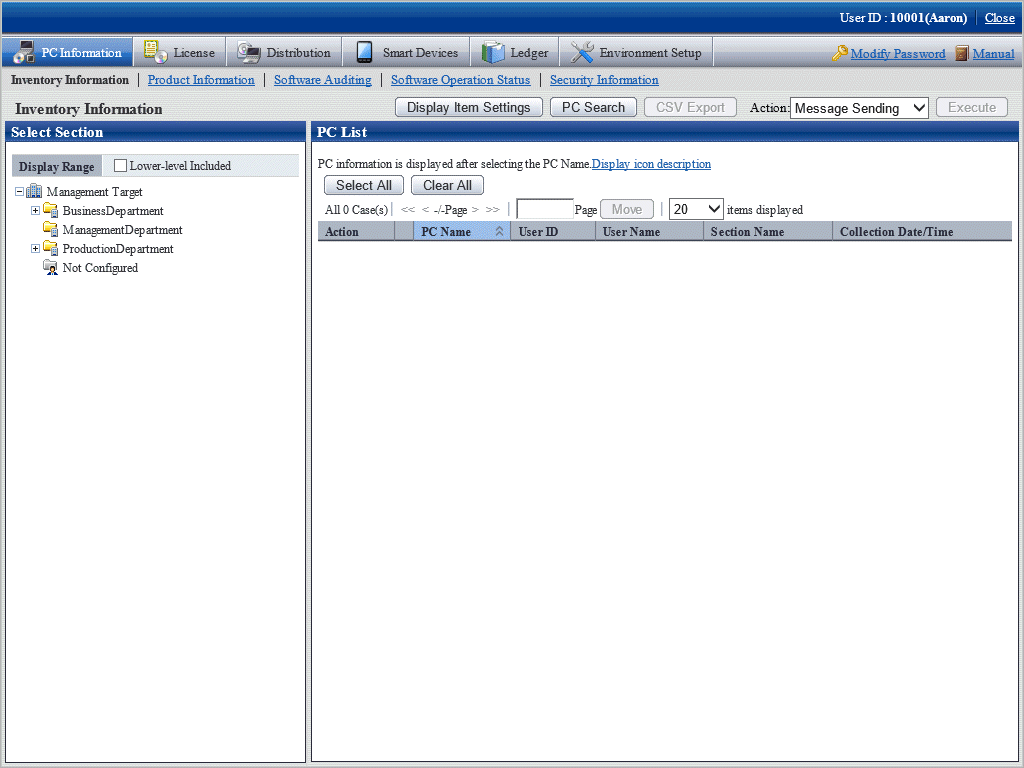
Select a section from the section tree in the field on the left.
The PCs under the selected section will be displayed in the field on the right.
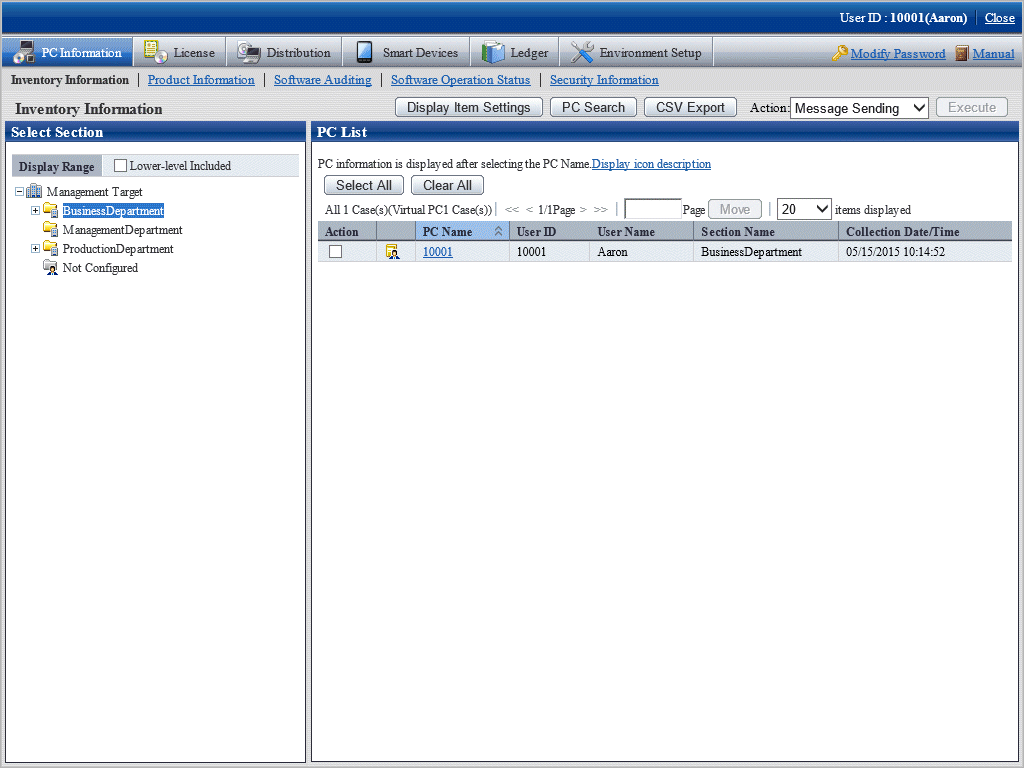
[Confirming with the colours of software dictionary version]
Version of software dictionary can be recognized by the icon colour of a PC. The relationship between icon colour and version is as follows.
![]() (Green):
(Green):
Indicates the information is collected with the latest software dictionary.
![]() (Yellow):
(Yellow):
Indicates the information is collected with the software dictionary of three generations before.
![]() (Red):
(Red):
Indicates the information is collected without a software dictionary or with the software dictionary of four generations before.
When the hardware information of PC shown in the field on the right is output to the file in CSV format, perform the following procedure. When not to output, proceed to the next step.
Click the CSV Export button.
The download window will be displayed.
Output the hardware information to a file in CSV format according to the window.
Click the PC name in the field on the right.
The inventory information of the clicked PC will be displayed.
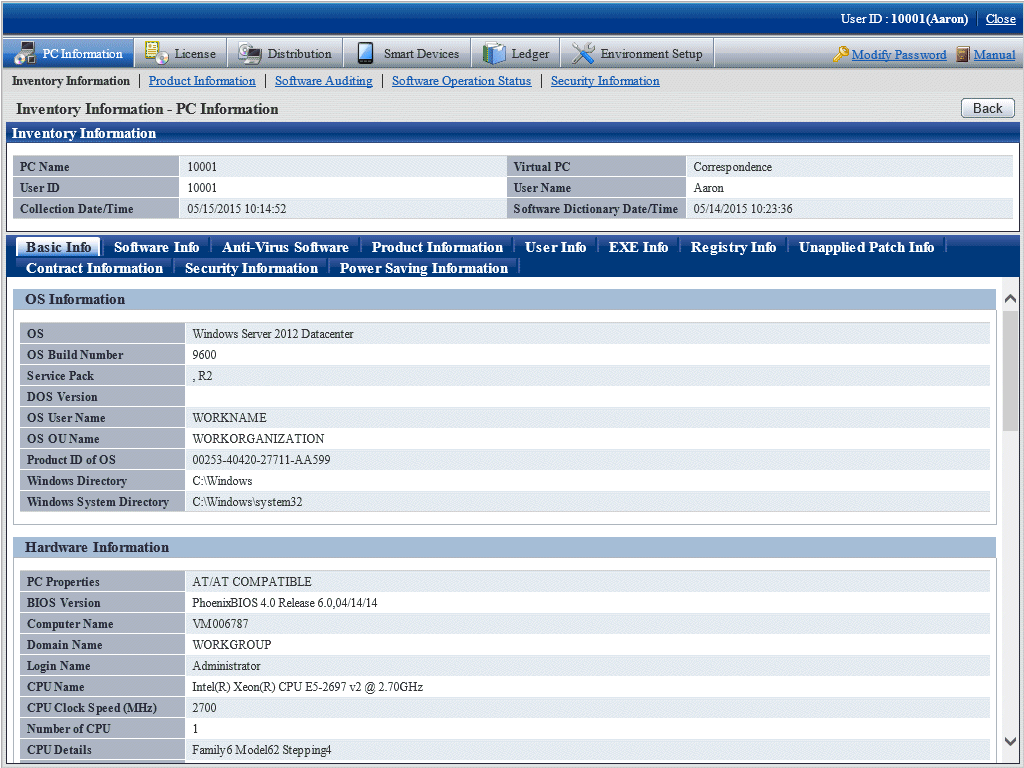
Select the following displayed items.
Basic Info tab
Software Info tab
Anti-Virus Software tab
Product Information tab
User Info tab
EXE Info tab
Registry Info tab
Unapplied Patch Info tab
Contract Information tab
Security Information tab
Power Saving Information tab
The selected window will be displayed. For display window, refer to the following description.
The basic information is displayed. The OS information and hardware information of PC can be viewed.

Note
When all the three DNS servers contain registered IP address, part of the information on the third DNS server will not be displayed.
Point
IP addresses in TCP/IP Information are expressed as follows:
To display both IPv4 and IPv6 addresses in dual stack environments, separate them with a forward slash (/).
IPv6 addresses are separated with a semicolon (;).
Temporary addresses are prefixed with a number sign (#). However, this applies only to inventory information collected by CT.
The software information will be displayed. The name of software on the selected PC can be viewed.
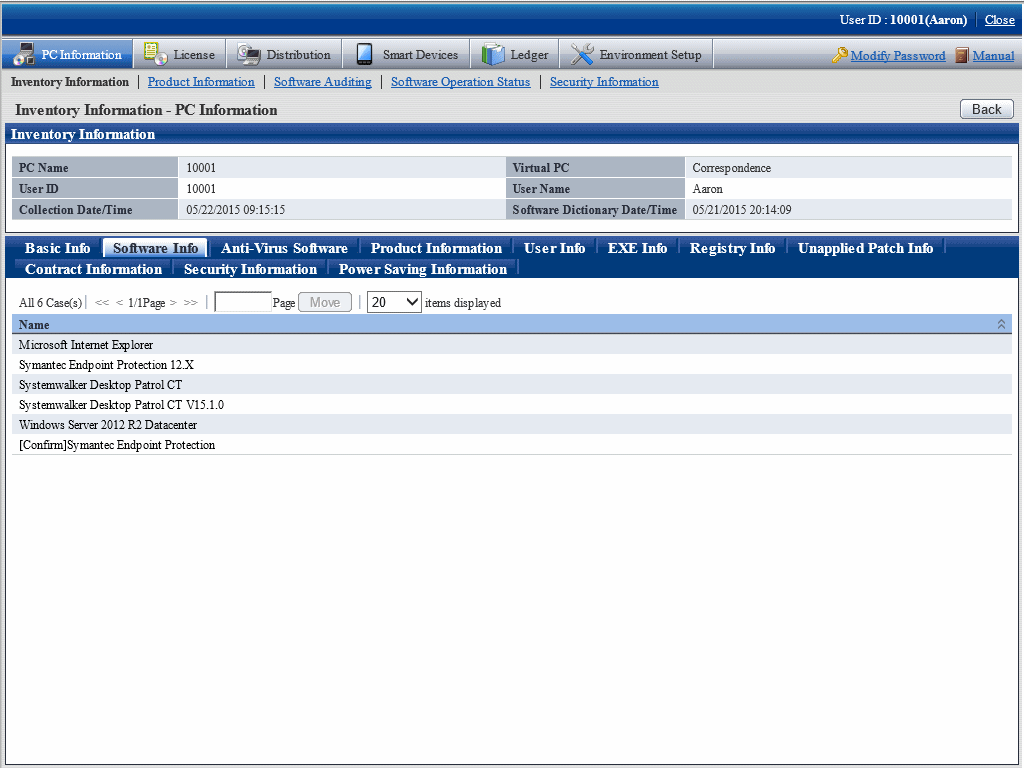
The information of anti-virus software will be displayed. The anti-virus software installed in the selected PC can be viewed.
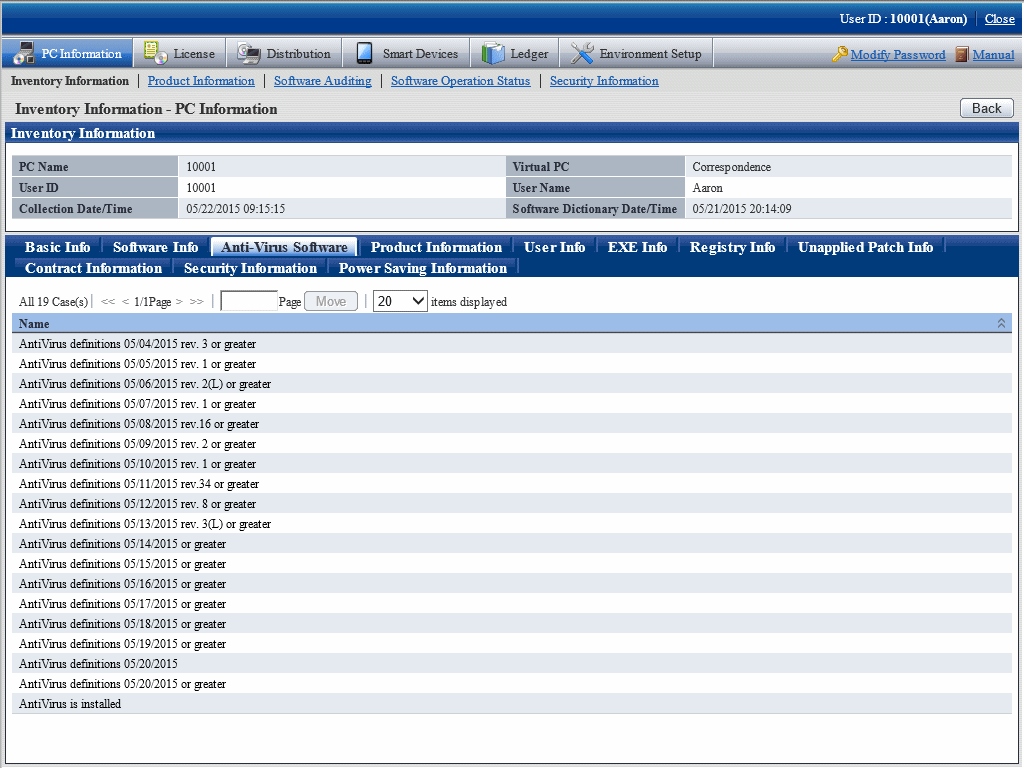
Product information will be displayed. The software displayed in a part of Uninstall a program and View installed updates in Add or Remove Programs or Programs and Features on the selected PCs can be viewed.
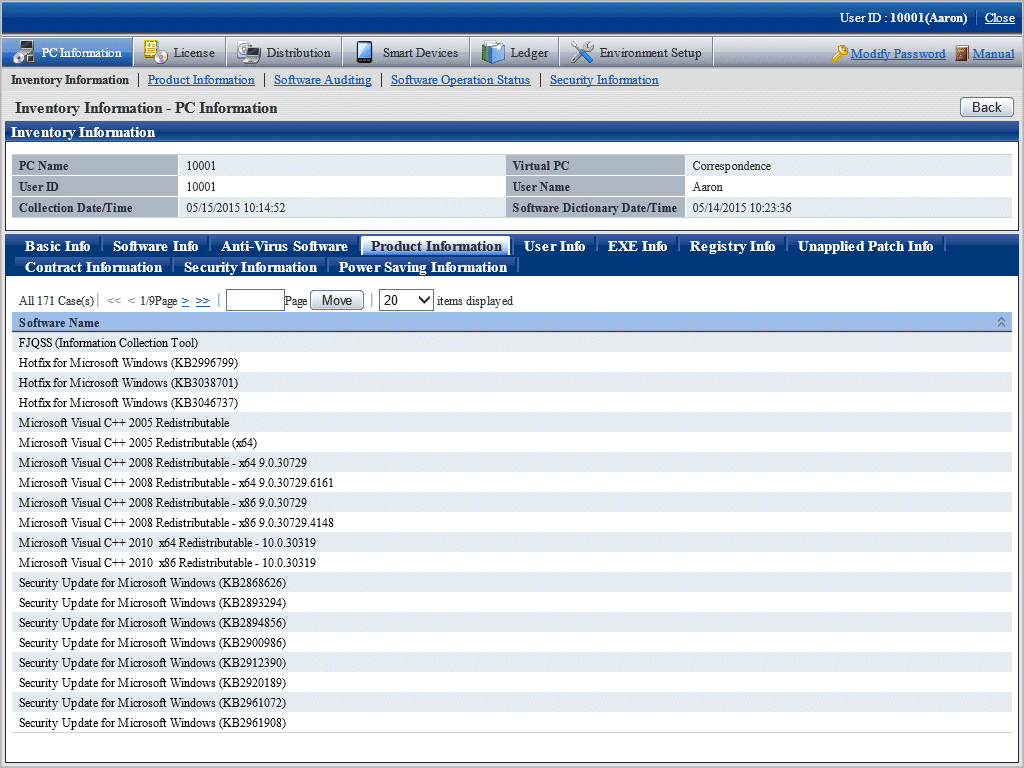
User information will be displayed. The user information of PC can be viewed.
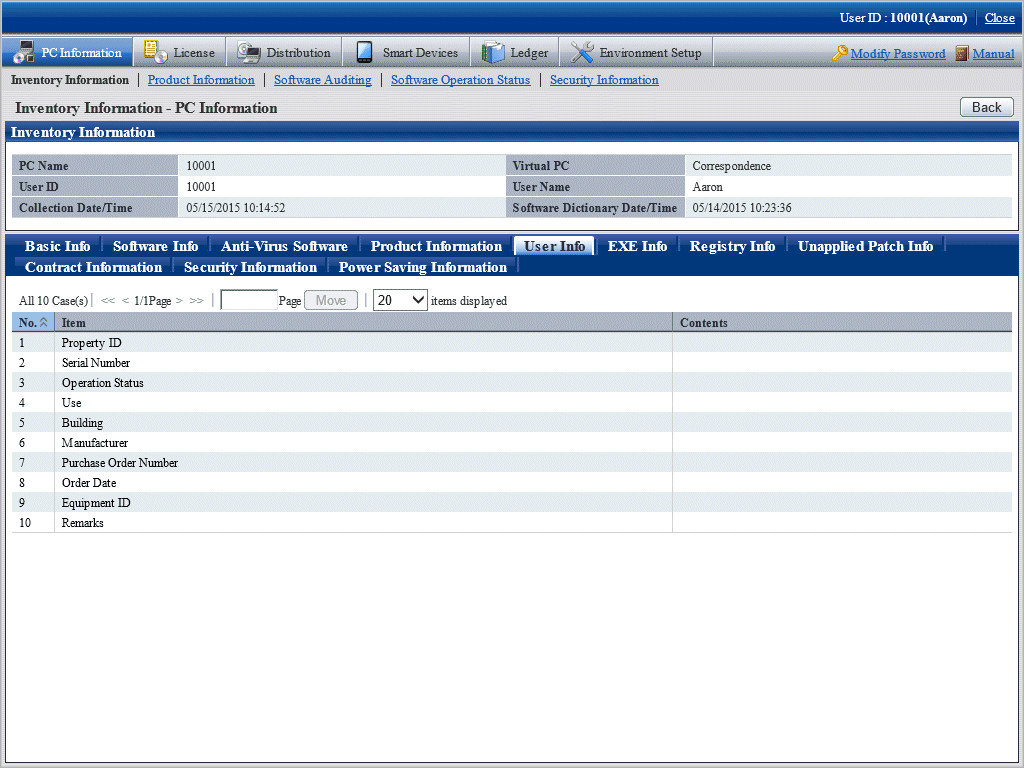
EXE information will be displayed. The absolute path of the executable file (extension is .exe) on the selected PC can be viewed.
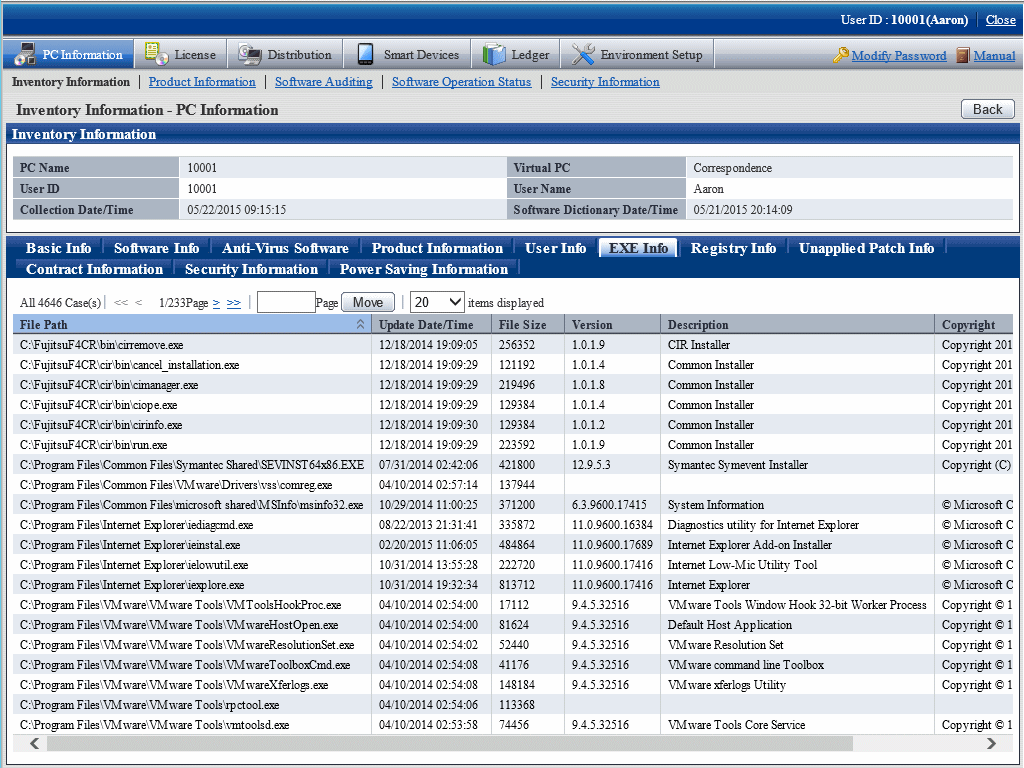
Point
If a collected file path exceeds 127 fullwidth characters or 380 halfwidth characters, the middle portion of the file path will be omitted when the path is collected and displayed, as in the example below.
Example:
C:\...(:::)...:1234ABCD1234ABCD1234ABCD
C:\... Lead portion of the path
(:::) Symbol indicating omission
... End portion of the path
:1234ABCD1234ABCD1234ABCD Unique string (25 characters) for each file
The registry information will be displayed. The registry information collected from the selected PC can be viewed.
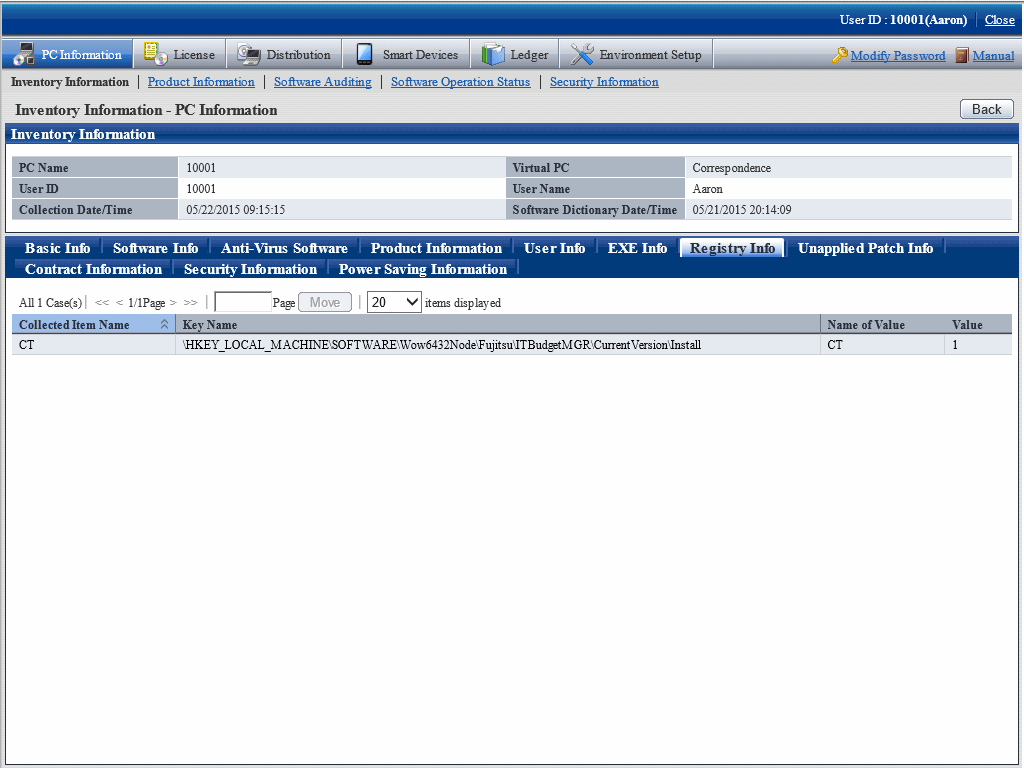
Description of the items in the above window is as follows.
Item | Description |
|---|---|
Collection Item Name | Display the Collection Item Name defined in the main menu. |
Key Name | Display the Key Name defined in the main menu. |
Name of Value | Display the Value Name defined in the main menu. |
Value | Display the registry information collected from CT. |
The information of patch that is not installed to CT can be viewed in the patch of automatic installation target.
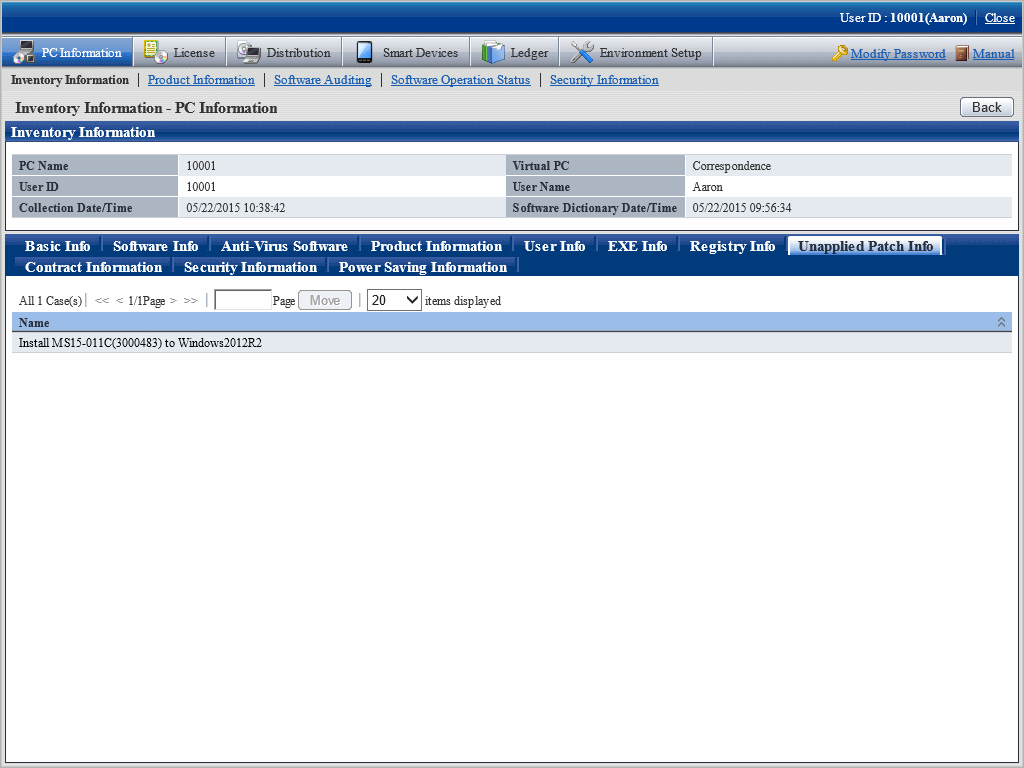
The contract information will be displayed.
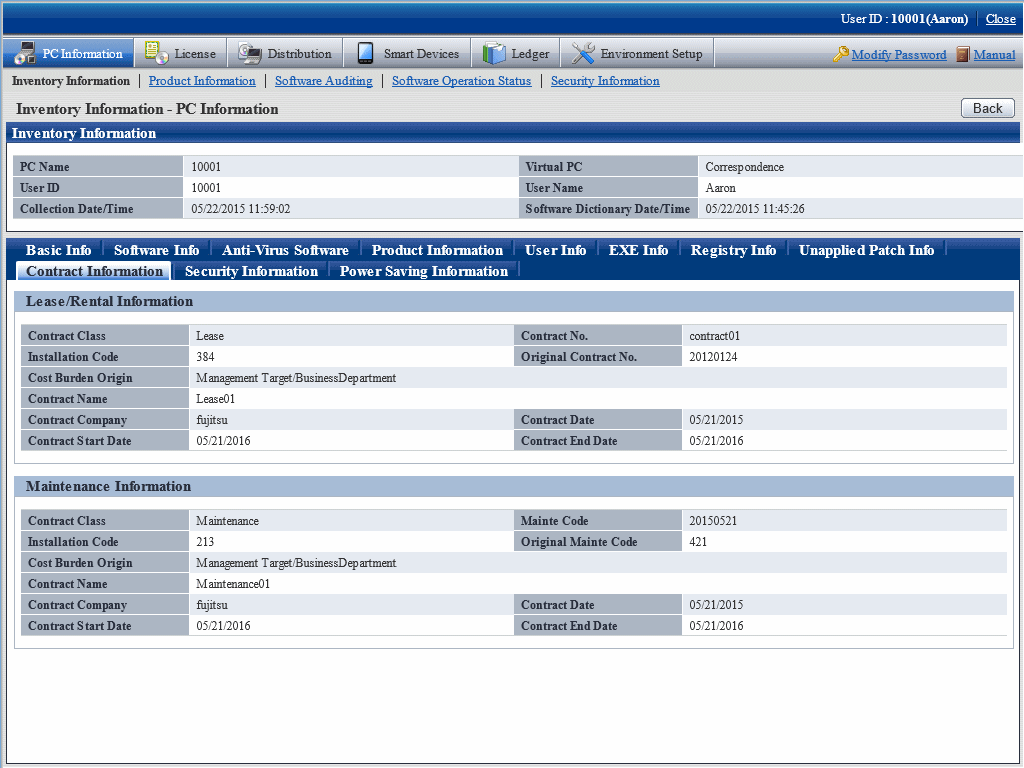
The security information will be displayed.
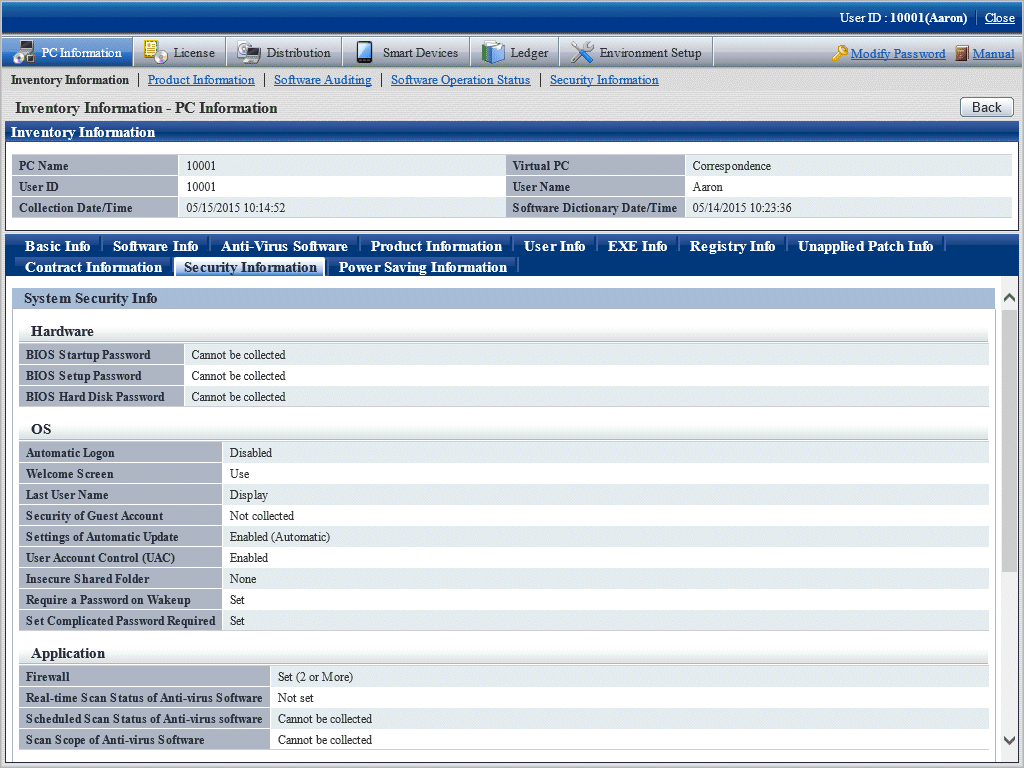
The power saving information will be displayed.
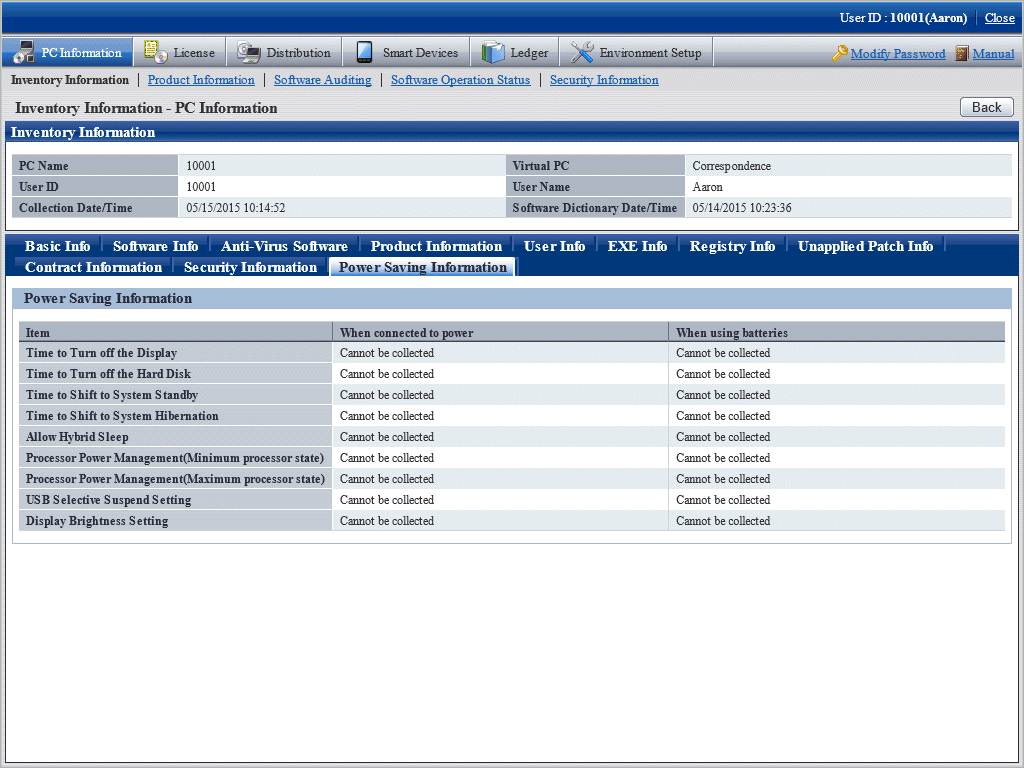
Through selecting the Log Management link displayed in the Inventory Information - PC Information window, the log search window of the same user ID/same PC name managed in Systemwalker Desktop Keeper can be displayed in a new window.
It is necessary for the browser to have been configured correctly beforehand. Refer to "Preparation on the PC in Which the Web Browser will be Used" > "Settings for linking with Systemwalker Desktop Keeper" in the Installation Guide for details.
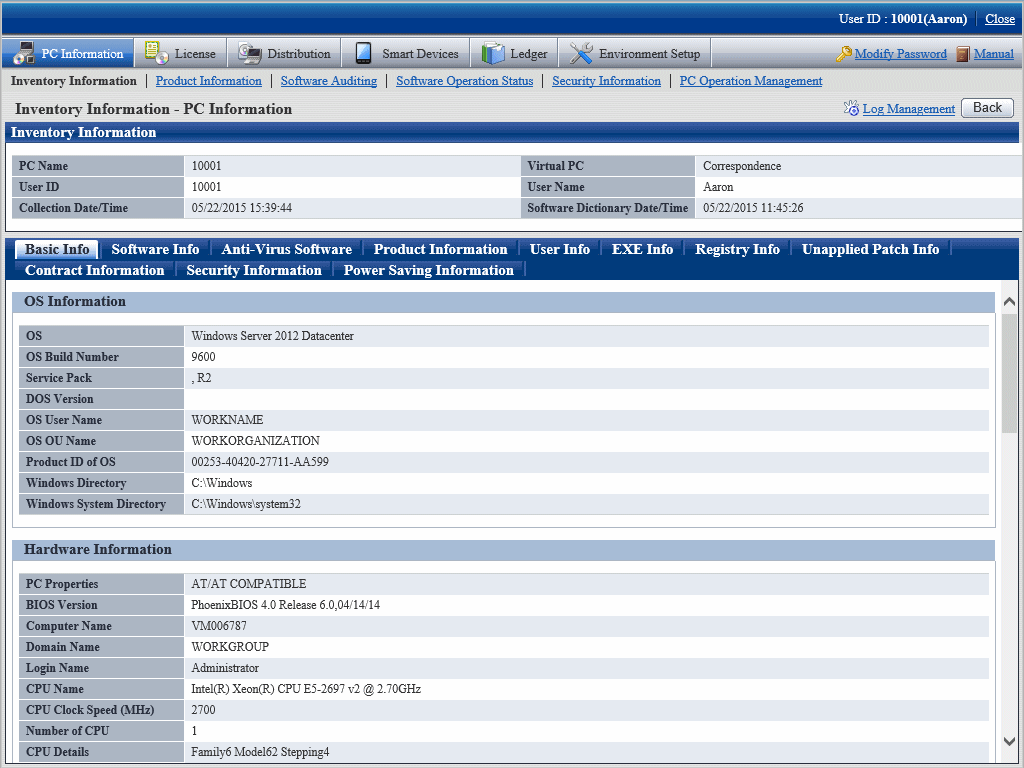
If Option > Settings of Status > URL of Desktop Keeper is not set in advanced or the automatic authentication of login ID when logged in to the main menu was failed, the link of Log Management will not be displayed.
In the log search window of Systemwalker Desktop Keeper that is displayed, log search can be performed. For details of the log search window, refer to Systemwalker Desktop Keeper User's Guide for Administrators.
Point
When multiple the log search windows displayed in the new window are displayed for each PC, click the Customized Level button in the zone of use from the Network Options of the Web browser being used and modify the Move window and frame between different domains to Enable, so that the display of multiple windows can be avoided.
How to view after searching
By searching for PC and selecting the PC displayed in window, the inventory information can be viewed.
The procedure is as follows.
Log in to the main menu, and click PC Information.
The PC Information window will be displayed.
Click Inventory Information.
The following window will be displayed.

Click the PC Search button.
The following window will be displayed.

Click the Select Section button, the following window will be displayed.
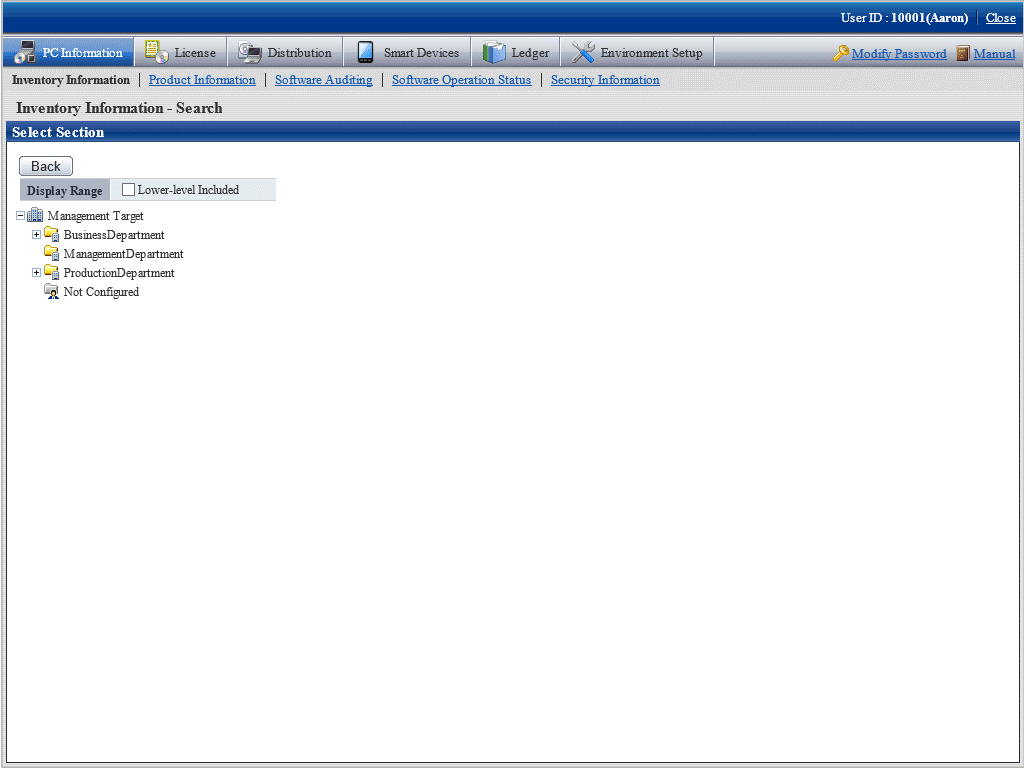
Enter the information to search PC and click the Search button.
The search result will be displayed.
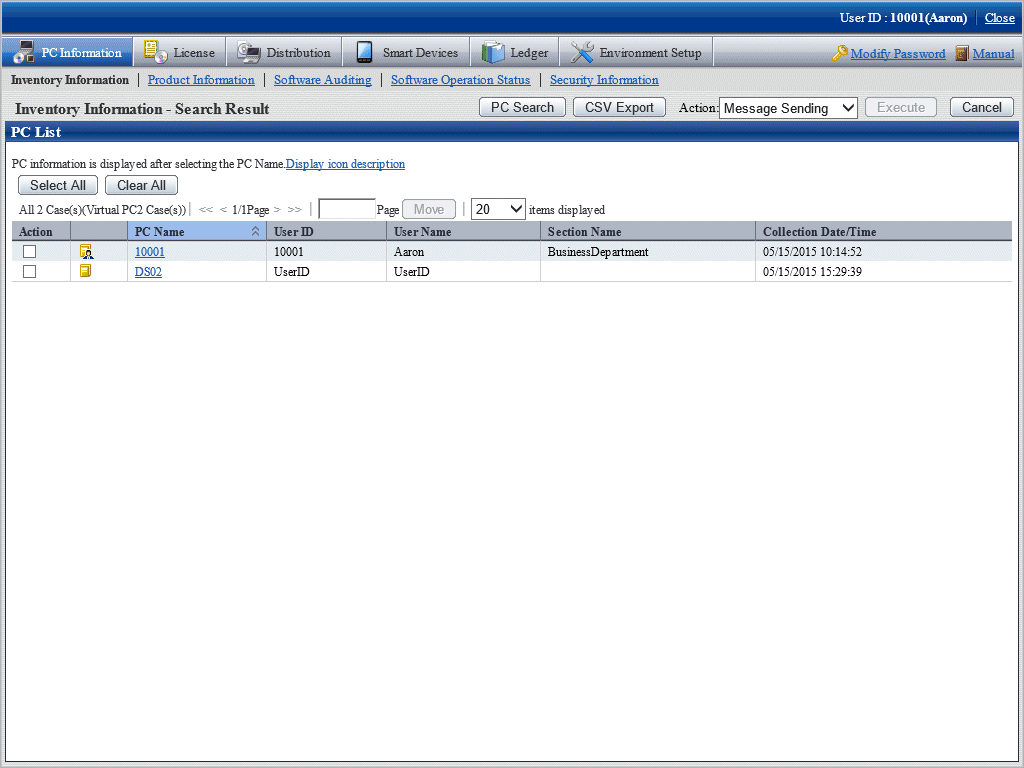
When the hardware information of PC shown in the field on the right is output to the file in CSV format, perform the following procedure. When not to output, proceed to the next step.
Click the CSV Export button.
Output the hardware information to a file in CSV format according to the window.
Click the displayed PC name.
The inventory information of the clicked PC will be displayed.
Select the displayed item.
The selected window will be displayed. For the display window, refer to "How to view from section tree".
Point
For IP Address (Partial match), specify ":" to include only IPv6 addresses, or "." to include only IPv4 addresses. If the target is an alphanumeric such as "10", the search will include both IPv4 addresses and IPv6 addresses.
IP addresses are searched according to the display priority specified in Option > Display settings.
How to modify the items displayed in the PC list
The default items displayed in the PC List of the Inventory Information window can be modified.
For inventory items except PC Name, the item can be displayed/hidden in the PC List freely.
This modification can be made only after login with system account, and only one setting can be performed in the system.
The procedure of modifying the displayed item is as follows.
Log in to the main menu, and click PC Information.
The PC Information window will be displayed.
Click Inventory Information
The following window will be displayed.

Click the Display Item Settings button. When logging in with an account that is not system account, the Display Item Settings button will not be displayed.
The following window will be displayed.
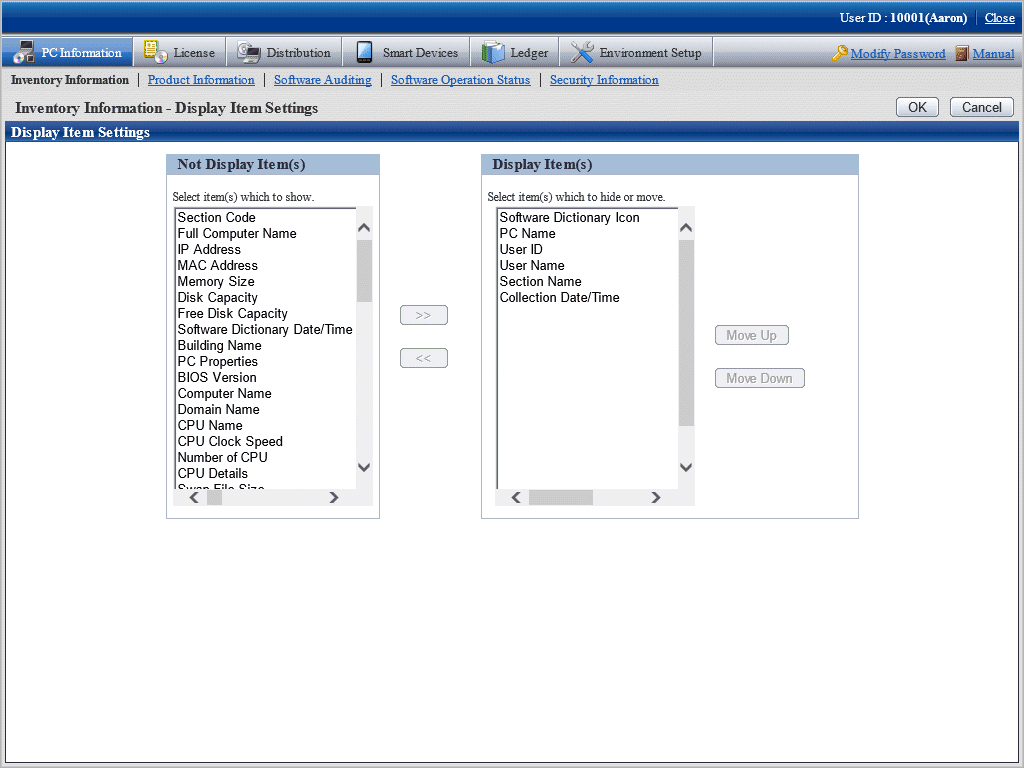
Perform the setting of displayed items according to the following procedure.
Select the item to be displayed in the PC List from the list of Not Display Item(s) on the left of window and click the [>>] button in the center of window. Multiple items can be selected.
The selected items will be added to the Display Item(s) on the right of window.
Select the item that does not need to be displayed in the PC list from the list of DisplayItem(s) on the right of window and click the [<<] button in the center of window. Multiple items can be selected.
The selected item will be deleted from the Display Item(s) on the right of window.
To modify the sequence of Display Item(s), select items from the list of Display Item(s) on the right of window and click the Move Up or Move Down button.
After the setting displayed items has completed, click the OK button.
The items displayed in the PC list will be modified to the items that have been set.
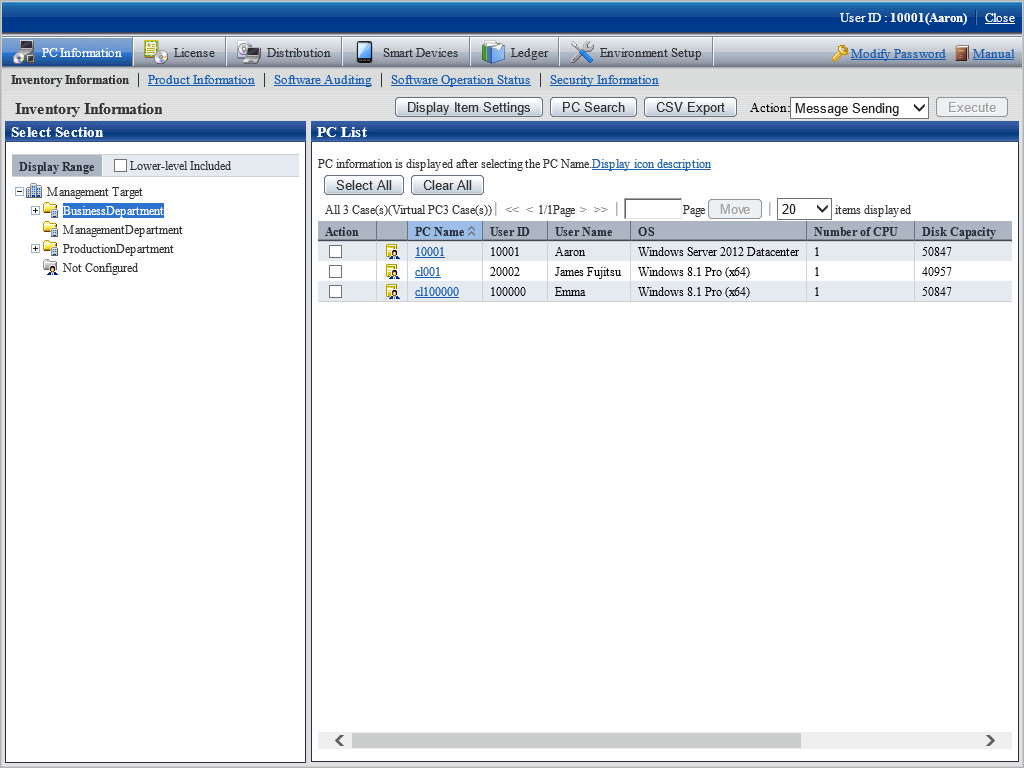
View inventory information of PCs without configuration
A PC without configuration is a PC of the user that is not registered to user management information or a PC of the user that has been deleted in the section tree in Environment Setup > Users of the main menu.
In the following window, when the section selection tree is in the state that Not configured is selected, the PCs displayed in the field on the right are without configuration.
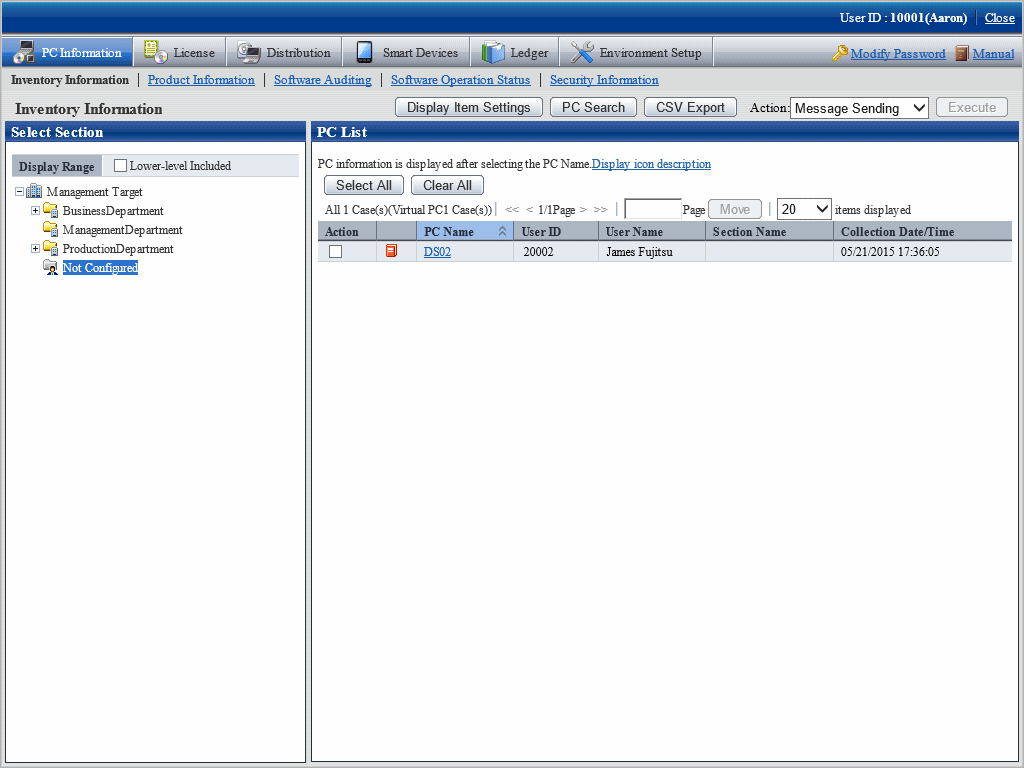
Hardware information of PCs without configuration can be saved to files in CSV format as well. Select Not configured in the section tree, click the CSV Export button and output according to the window.
In addition, same as the PC of user registered in user management information, inventory information can be viewed.
When PCs without configuration exist, perform the following operations.
When the PC is required, a PC without configuration can be moved to section in Environment Setup > Users of the main menu.
When the PC is not required, a PC without configuration can be deleted in Environment Setup > Users of the main menu
When PCs without configuration exist, perform the following operations.
In Select section of entry column of search condition, set selected section to Not configured.
Output to files in CSV format.
Open the file output in CSV format to confirm PC and users, and perform the following operations.
When the PC is required
Create the user management information file of the user that owns the PC.
For confirming whether the section to which each user of user management information file belongs is correct, refer to "2.1.5 Create User Management Information" to register a user. When not belonging to a section, refer to "2.1.4 Create Section Management Information" to register a section.
When the PC is not required
Create the user management information file of the user that owns the PC.
For confirming whether the section to which each user of user management information file belongs is correct, refer to "2.1.5 Create User Management Information" to delete a user.
How to output CSV files
The collected information can be output as CSV file. After searching and refining, the result will be saved to CSV files. When output without searching, all collected information will be saved to CSV files.
To output to CSV file, click the CSV Export button to output according to the window.
Operation action
In the inventory information window, the following operation Action can be performed.
Message Sending
Inventory Collection
Inventory Delete
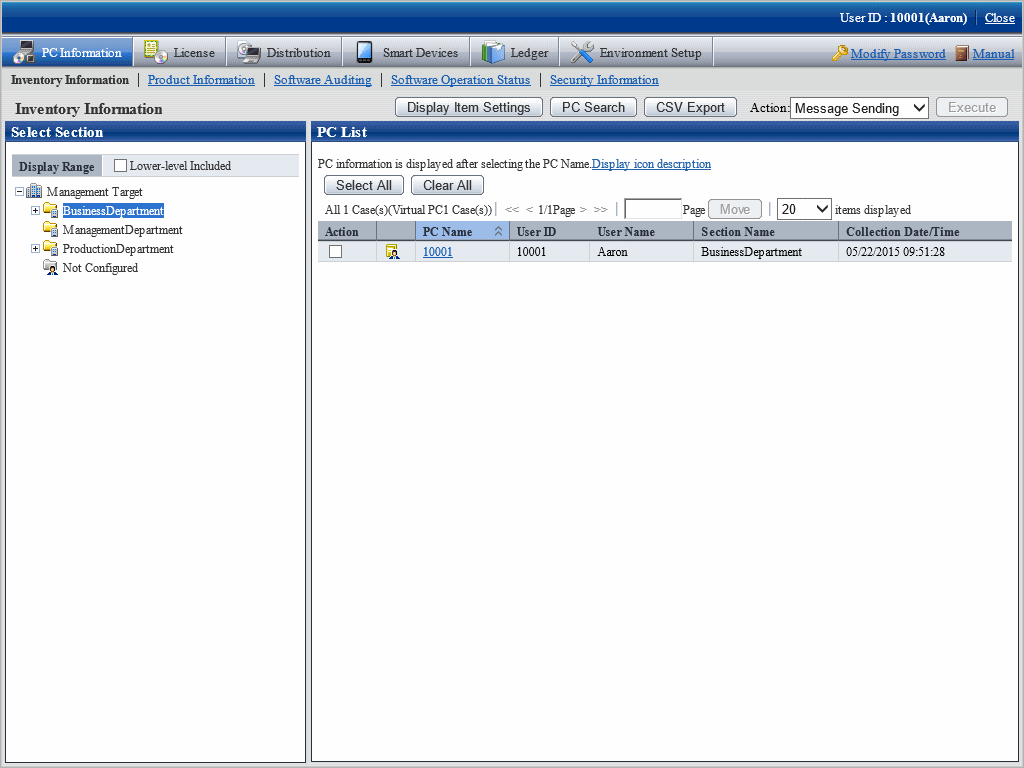
Select the PC that requires processing from the PC list and select the content of processing to be performed from the pull-down menu of Action.
Click the Execute button and the window for confirming the processing content corresponding to the processing will be displayed. After confirming the content, click the OK button.
The corresponding processing will be performed for the selected PC.
In the inventory information window, the following operation Action can be performed (refer to "About the content of selection item of 'Action'" in "Operation action" for details).
Message Sending
Inventory Collection
Inventory Delete